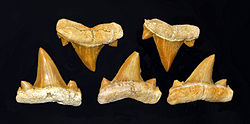Cretalamna
| Cretolamna Temporal range: [1]
| |
|---|---|

| |
| Whole body fossil of Cretolamna | |

| |
| Fossil teeth of C. biauriculata from Khouribga (Morocco) | |
| Scientific classification | |
| Kingdom: | |
| Phylum: | |
| Class: | |
| Subclass: | |
| Superorder: | |
| Order: | |
| Family: | |
| Genus: | †Cretolamna Glikman 1958
|
| Species | |
Cretolamna[3] is a genus of extinct mackerel shark that belonged to either the family Cretoxyrhinidae or Otodontidae.
These sharks lived during from the Barremian of the Cretaceous period to the Mid Miocene epoch, approximately from 130.0 to 13.65 million years ago.[1][2][4] It is considered by many to be the ancestor of the many of the famous shark genera, such as the mako, great white, Angustidens, and Megalodon sharks.
Etymology
The genus name Cretolamna means Cretaceous Lamna, as the first specimens of these Lamniformes sharks have been found in Cretaceous aged sediments.[2]
Size estimation
The fossils of Cretolamna are of teeth and a few scattered vertebrae. Most teeth average about 1 to 2 cm (about .5 to .75 in) long. They are broad with small cusps at the base of the main crown.[2]
Most estimates put the shark's length at about 2–3 m (6.6–9.8 ft) long[2] with the largest specimens being about 3.6 m (12 ft) in length.[5]
Distribution
This shark genus is one of the most successful, as it is widely distributed throughout time and all over the world.[2] Cretolamna was a widespread genus in North Africa (Morocco) and North America on the East Coast and in the Midwest. Deposits in Morocco are usually Eocene in age, while most deposits in the U.S. are of Cretaceous and Paleocene age.[6] C. maroccana is more prevalent in Morocco, while C. appendiculata is more prevalent in the United States. Both species overlapped at one point in time.
Diet
Cretolamna was a predator and preyed upon large bony fish, turtles, mosasaurs, squids, and other sharks. It was a medium-sized predatory shark.[7]
Evolution
Cretolamna is believed to have evolved into the genus Otodus sometime in the Paleocene. Otodus is believed to have evolved later into the Carcharocles genus. Others believe that Cretolamna evolved into the Paleocene shark Palaeocarcharodon, which some think evolved into Carcharodon carcharias.[8]
See also
References
- ^ a b c d e f Fossilworks
- ^ a b c d e f Prehistoric Wildlife
- ^ The spelling of the name is controversial; the original spelling is Cretalamna, but currently both spellings are in use. For comments on the spelling of the genus name see: Mikael Siverson, Johan Lindgren, Michael G. Newbrey, Peter Cederström and Todd D. Cook (2015). "Cenomanian-Campanian (Late Cretaceous) mid-palaeolatitude sharks of Cretalamna appendiculata type". Acta Palaeontologica Polonica. 60 (2): 339–384. doi:10.4202/app.2012.0137.
{{cite journal}}: CS1 maint: multiple names: authors list (link) - ^ Welton & Farish, Bruce J. & Roger F. (1993). The Collectors's Guide to Fossil Sharks and Rays from the Cretaceous of Texas. Before Time.
- ^ Yoost, Derek. "Porbeagle Sharks". Retrieved 14 May 2012.
- ^ Yoost, Derek. "Potomac River Fossils". Retrieved 14 May 2012.
- ^ Kent, Bretton W. (1987). Fossil Sharks of the Chesapeake Bay Region. Egan Rees & Boyer Inc.
- ^ "Carcharodon Megalodon". Retrieved 14 May 2012.
